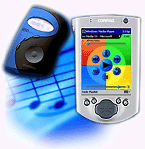Set the soundtrack for a day of fun

It's one thing to use a portable tape- or CD-player when you're heading out for a day of fun. But what about that skipping, dropped-out, messed-around sound every time you step too hard or your bike or car rattles over a pothole? Not to mention spools of snarled tape erupting out of a stalled tape player.
Here is some good news. With Windows Media Player and a handy portable digital audio device, you never have to face those heartbreaking situations again. After all, it's easy to store a ton of music on your hard disk, then download your favorite tunes to your digital audio device.
Get a peaceful easy feeling
Copying audio files to your digital audio device is as simple as sitting down at your computer, attaching your device, and clicking a few buttons:
- In Windows Media Player, click Media Library, click My Playlists, and then click the playlist you want to download.
- Click Portable Device. In the Music to Copy list, select the audio files you want to copy and clear the ones you don't.
- Click Copy Music.
All selected tracks in the list are copied to the portable device, as space allows. (The legend on the lower-right edge of the display tells you the percentage of free space on your portable device and gives an estimate of the percentage of disk space required for the files that you want to copy)
- Repeat steps 1-3 for any other playlist or audio file you want to copy to your portable device.
Note To transfer a licensed file, your portable device may require a hardware serial number. The person or company that provides a licensed file decides license rights; not all files will work after you copy them to a portable device.
Want more tunes?
When you copy an audio file to your portable device, you can choose to compress the file so that it uses less space on your portable device. By default, Windows Media Player will compress all files to a bandwidth of 128 kilobits per second (Kbps). If your file is smaller than this, it will not be compressed. Typically, the more compression you use, the more audio quality you sacrifice. On the other hand, when files are smaller you can store more music on your portable device.
The following compression rates are available:
- 32 kilobits per second (Kbps), 22 kilohertz (kHz), Stereo. This format takes up the least amount of storage space on your portable device. It is a good choice for spoken word audio files or 64-Kbps .mp3 files.
- 64 Kbps, 44 kHz, Stereo. This format produces sound that is near CD-quality, but it also takes up less storage space on your portable device. It is a good choice for use with source files, such as 128-Kbps .mp3 and Windows Media files that have already been compressed.
- 128 Kbps, 44 kHz, Stereo. This format produces CD-quality sound, but it takes up more storage space on your portable device. It is a good choice when you want near exact duplication of a sound track from a CD or a source .wav file.
What's the frequency, Kenneth?
You can set the quality level of the music that you copy from your computer to your portable device:
- On the Tools menu, click Options, and then click the Portable Device tab.
You will see that Let Windows Media Player decide is selected by default; Windows Media Player automatically sets the quality level of the music that is copied to your portable device.
- To set your own quality level, click Select quality level and use the slider to make your choice.
Next step: Go have a lot of fun
Now that you've got a digital audio device loaded with tunes, you're ready for a big day outdoors. Donít forget the sunscreen. Nobody likes a sunburn. And don't forget where you leave your portable digital audio player. You know how much you would hate to lose that now.
|
| |
Music to go
Looking for digital music players to use with Windows Media Player? Check out Windows Media On-the-Go
 for a wide variety of great choices on handheld digital music players that support Windows Media.
for a wide variety of great choices on handheld digital music players that support Windows Media.
|
|
|
|
